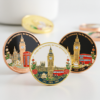Medals symbolize achievement, honor, and legacy. From athletic triumphs to corporate milestones, crafting these timeless emblems requires precision, artistry, and cutting-edge technology. Here’s an inside look at how professional medals go from concept to tangible glory.
The Art of Excellence: A Step-by-Step Guide to Medal Manufacturing
Medals symbolize achievement, honor, and legacy. From athletic triumphs to corporate milestones, crafting these timeless emblems requires precision, artistry, and cutting-edge technology. Here’s an inside look at how professional medals go from concept to tangible glory.
Step 1: Design & 3D Modeling
The Blueprint of Excellence
Every medal begins as an idea. Designers use software like Adobe Illustratoror Rhino 3Dto transform concepts into vector files. Key considerations:
- •Detailing: Intricate patterns or text must be >0.3mm deep to withstand molding.
- •Dimensional Limits: Standard diameters range from 50mm to 90mm.
- •Brand Alignment: Tokyo 2020’s kinetic medal design mirrored Japan’s tech-forward ethos.
🖌️ Pro Tip: Submit high-resolution EPS/AI files (300+ DPI) to avoid pixelation.
Step 2: Die Creation & Tooling
The Heart of Precision
Steel dies carve the medal’s features into metal blanks. Two methods dominate:
| Technique | Use Case | Tolerance |
|---|---|---|
| Stamping Dies | High-volume production | ±0.1mm |
| CNC Machining | Complex 3D shapes | ±0.05mm |
🔨 Fun Fact: Olympic medal dies weigh up to 20kg and take 200+ hours to engrave!
Step 3: Metal Selection & Blanking
Choosing the Foundation
Material choice impacts aesthetics, weight, and cost:
- •Zinc Alloy: Budget-friendly; electroplating creates gold/silver finishes.
- •Brass: Premium feel; naturally antimicrobial.
- •Pure Iron: Used for military medals; weights ~120g.
Blanking machines punch discs from metal sheets, then deburr edges for safety.
Step 4: Striking & Finishing
Where Form Meets Function
Blanks enter hydraulic presses at 200-1000 tons of force, imprinting designs in milliseconds. Post-strike processes include:
- 1.Grinding/Polishing: Smooth rough edges.
- 2.Electroplating:
- •Gold: 99.9% pure gold over copper/nickel base (5μm min. thickness).
- •Antique Finish: Chemical patina + buffed highlights.
- 3.Enameling: Colored epoxy fills recessed areas (e.g., NYC Marathon’s blue skyline).
✨ Pro Insight: Rio 2016’s sustainability twist: Silver medals contained 30% recycled materials.
Step 5: Quality Control
Perfection is Non-Negotiable
Each batch undergoes rigorous testing:
- •Dimensional Scan: Laser check against CAD specs.
- •Salt Spray Test: 48-hour exposure to verify plating durability.
- •Adhesion Test: Tape-pull on coatings to prevent flaking.
Step 6: Ribbons & Packaging
The Final Flourish
- •Ribbons: Polyester/satin weaves (custom widths: 30–50mm).
- •Attachment: Secure with fold-over tabs or spring-loaded clips.
- •Presentation: Velvet boxes, acrylic stands, or eco-friendly sleeves.
Spotlight: Bespoke Medals in Action
- •Marathon Races: Color-graded bands for finisher tiers.
- •Corporate Awards: Logo debossed + employee names laser-engraved.
- •eSports: Glow-in-the-dark resin inserts (like LoL Championship medals).
Sustainable Alternatives 🌱
Modern manufacturers now offer:
- •Recycled Metals: Post-industrial brass/bronze.
- •Bioplastic Medals: For temporary/tree-planting events.
- •Plantable Ribbons: Embeds with wildflower seeds.
Why Partner with Professionals?
Medal-making blends tradition and innovation. Expert producers ensure:
✅ Durability: Scratch-/tarnish-resistant finishes.
✅ Scalability: Produce 100 to 100,000+ units.
✅ Customization: Unique shapes (hexagons, shields), mixed metals, or embedded crystals.
Whether you’re honoring athletic prowess, academic excellence, or team achievements, the journey from raw metal to polished triumph is where artistry meets engineering. Request a free design consult to create medals that turn moments into legacies.
➡️ Inspired? Share how yourorganization celebrates greatness below!🏅
Medal images and customization samples available at magicgiftcustom.com




Add comment